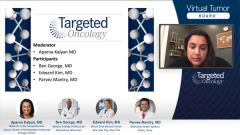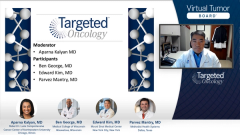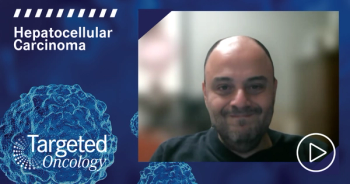
Case 1: The LEGACY Study of Y90 Radioembolization in Unresectable HCC
Shared insight on the results of the LEGACY study, which utilized Y90 transarterial radioembolization for patients with unresectable hepatocellular carcinoma.
Episodes in this series

Transcript:
Aparna Kalyan, MD: The LEGACY study looked at transarterial radioembolization [TARE] for solitary unresectable HCC [hepatocellular carcinoma]. The primary end point was to assess objective response rate in RECIST and to look at the duration of response. Additionally, they looked at overall survival as an end point. This was a multicenter, single-arm retrospective study looking at patients who were treated between 2014 and 2017. The main eligibility criteria for the trial were that patients had to have a solitary HCC lesion less than or equal to 8 cm with an ECOG performance status of 0 or 1 and a Child-Pugh score of A.
These are the baseline variables. I want to focus on the Child-Pugh score as well as the treatments that patients received. Two-thirds of patients had an A5 CPT [Child-Pugh-Turcotte] score, and most of the patients had tumor size less than 5 cm. For the radioembolization component, a majority of the patients had received radiation segmentectomy, which Dr Kim talked about earlier.
Looking specifically at the results in terms of RECIST, the confirmed overall response rate by both local mRECIST and mRECIST was greater than 65%. If you look at the local mRECIST, it was 72%. So we’re all on the same page, local mRECIST refers to the outcome in the radioembolization-treated region. The best overall response rate was around 88%. When we look specifically at the responses itself, 84% of patients had a CR [complete response], which is an incredibly good number. When you combine the PR [partial response] plus CR rate, close to 90% of patients did incredibly well. The duration of response in this study was around 15 months. This is important for these patients because these are patients who have 2 competing illnesses. To be able to go 15 months is incredibly good.
Finally, looking at the PFS [progression-free survival] and overall survival, this Kaplan-Meier curve shows the dark-green line as the localized mRECIST. Clearly, there’s a favorable outcome in terms of time greater than 54 months. If you look at overall survival at 24 months, it’s around 94%. At 36 months, it’s close to 86%. Historically, the concern has always been the safety issue, and this study clearly proved that in terms of AEs [adverse events] that were seen. Most of it was manageable and expected in terms of cytopenias, which we tend to see in this patient population, but nothing that was unexpected.
With this, the double AASLD [American Association for the Study of Liver Diseases] came out with the position statement that said that TARE should be the primary locoregional therapy for unresectable HCC. The only caveat is that this speaks specifically in relation to patients who do not have portal vein thrombosis or portal vein extension. Similarly, efficacy has TACE [transarterial chemoembolization] in terms of overall and progression-free survival. Also, when we look at the health-related quality-of-life measures, patients did significantly better with Y90. Do any of our panel members have any comments about the LEGACY study?
Edward Kim, MD: I love this study. We were part of it. It validates what we’ve been doing for over a decade, which is to treat in a selective fashion with radioembolization. That’s taking a page out of our surgical colleagues’ playbook when they do anatomic resections or wedge resections in the area, because we’re trying to preserve as much nontumoral possible. In that study, we gave very high doses, more than 400 gray, which is a very high level of radiation. But because the Y90 is a beta emitter, it doesn’t travel further than 3 mm in soft tissue. It just localizes in that treated perfused area, and it’s quite elegant because we’re using the arteries and the perfused liver and treating in that region. Of course, I was very happy with the results and the AASLD position statement. More important, there was FDA approval of the glass microspheres for the treatment of HCC.
Parvez Mantry, MD: The only thing I’ll add is portal vein thrombosis. We’ve been doing Y90 for the last 17 years at my institution [Methodist Health System]…. Unlike TACE, we can use Y90 because it’s microembolic in portal vein thrombosis; therefore, it’s much safer. We don’t see major liver infarctions, yet we achieve a result. This is a multimodality treatment, with all the results. The complete response isn’t fabulous. But in terms of long-term duration of response and the best survival, in patients like this, in almost all cases, we’ll combine it with systemic chemotherapy and immunotherapy.
Ben George, MD: I agree with everything my colleagues mentioned. At the same time, these treatment decisions, ideally, should be made in a multidisciplinary setting. That way, there’s consensus on the right approach for each patient. Second, pay attention to the biology of the diseased and also the systemic and financial toxicity to the patient, particularly in someone who presents with a single lesion. It might be reasonable to perform local immunotherapy and then watch over time and see what happens. As long as the physicians are in a multidisciplinary setting, we are doing right by the patient.
Edward Kim, MD: Absolutely.
Transcript edited for clarity.













































